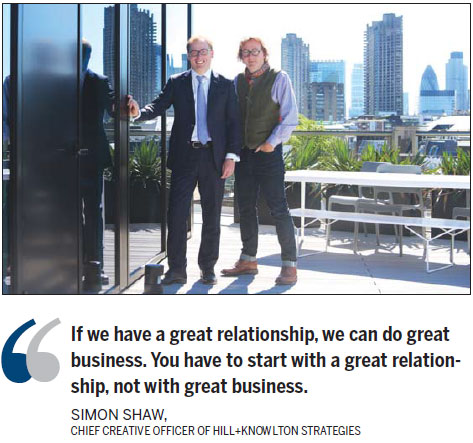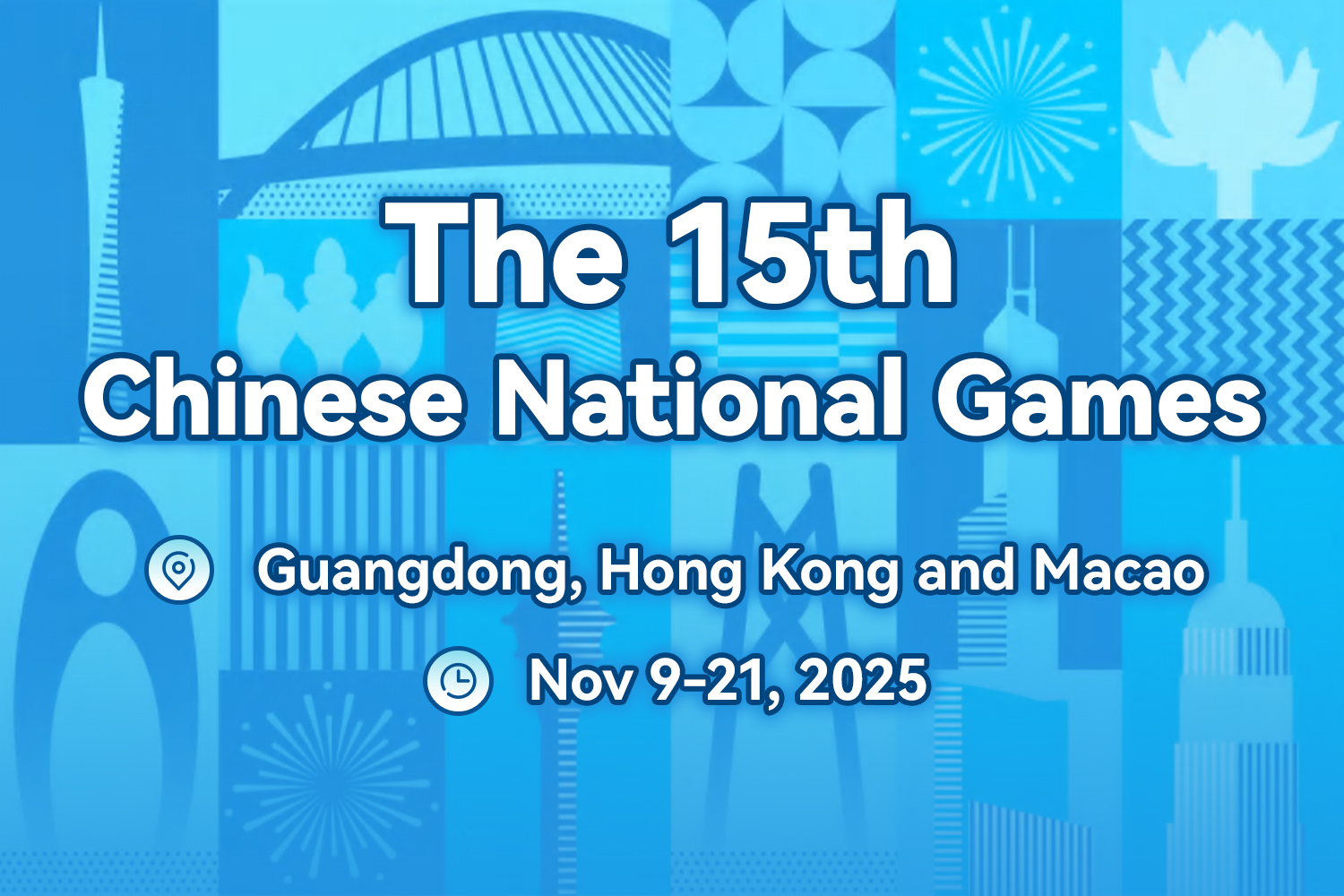To be 'human' is divine

Changes in channels of communication prompt public relations professionals to embrace business model that emphasizes clients' individuality
As the digital era makes interaction with individuals increasingly important for companies, the main form of business communication in the future should be B2H (business to humans) rather than business to business or business to consumers, according to public relations experts.
"Because the whole world has been changing as a result of social media, from B2B to B2C and now B2H, whatever your service, you have to listen to individuals," says Ye Yu, executive vice-president of Asia-Pacific at Hill+Knowlton, a global public relations company headquartered in New York.
|
Below: Simon Shaw (right), chief creative officer of Hill+Knowlton Strategies, and Richard Millar, UK CEO and global chairman of creative strategy of the company. Photos provided to China Daily |

China is Hill+Knowlton's third-largest market after the United States and the United Kingdom, and the company also has 90 offices in 52 countries.
For Ye, irrespective of the changes and cultures in different countries, the fundamental element is always the same: We are all human beings.
Simon Shaw, chief creative officer of Hill+Knowlton Strategies, says, as a company, being human not only means catering to customers via your products, but also approaching them as friends.
He believes that Chinese companies looking to go global should emulate the ways in which individuals behave: "You just go and approach a country in the same way you would an individual; how do you introduce yourself, What is the character you bring? What are your beliefs? It's not just your products, not just what you want to sell. It's more than that. It's how you can be accepted and become part of the culture of that country."
Shaw says many companies focus too heavily on products, but sometimes, when customers choose one brand of phone over another, it's not necessarily that the quality or functionality of one brand is better than that of a rival, but simply that customers believe in the value of one brand over another.
"To move into different cultures, you cannot just stand on a stage and say, 'My products are the best'. You have to stand there and say, 'I believe this, that is why I made this, as a response to that'," he says.
Shaw was speaking on a trip to China designed to help him learn about the latest trends in creative strategy development in the public relations industry. He says Chinese clients are becoming more receptive to creativity, and in light of that, the company - which already has central creative strategy centers in London and New York - will open creative centers in Beijing, Shanghai and Guangzhou this year.
"It's not just London to China, we are also taking knowledge about China back to London," he says, adding that the thing he most wanted to see was the human side of China, because when people-to-people exchanges grow, business will follow.
"If we have a great relationship, we can do great business. You have to start with a great relationship, not with great business. Because if it's purely about products, then it has to be what I need, rather than feelings or a desire to work together," he says.
Shaw has been impressed most by the open-mindedness he's encountered during his trip, a marked contrast to many other places he has visited where people didn't listen very patiently.
"But coming here, (they said) tell us more, tell us more. The open-mindedness, the willingness to absorb news ideas and new thoughts impressed me the most," he says.
According to Richard Millar, UK CEO and global chairman of creative Strategy of the company, public relations professionals in the new era should act as "idea catchers", "technology speculators", "campaign architects", and "creators of culture".
"Traditionally, our public relations industry has been generalist. We've been good at lots of things, but maybe not specialists in different areas, and I think the agenda will drive a cultural change within our network," he says.
Millar says public relations communicators should be curious about their own agencies and cultures, in order to bring the things they learn in China to London, and vice-versa.
"It's (about) joining the dots between different things, you see, different things you discover to create new ideas for our clients," he says, adding that London is the world's creative center, and that creativity comes from the street. "Our cultural awareness is that we think professionals need to look around to see what's happening on the street, to catch those ideas and translate them in a way in which brands and companies can express themselves."
Because the world is changing rapidly, companies such as Hill+Knowlton need to learn about changes in China and the UK, but also about other places, and then mull the factors over and see where they go. However, it's sometimes difficult to see the end result because everything is changing so quickly, according to Millar.
The diverse and rapid changes in communication channels in China - for example, popular social networking tools, such as microblogs and the instant-messaging app, WeChat - present a huge challenge to the industry because different channels add a wider range of colorful choices for the dissemination of information.
"It is like having different colors to paint a picture - the more channels you have, the more colors you have. The more you can piece together, the more interesting the story. So every time you have a new channel, it's like a new color of paint. You can add many more layers to a story, which makes it far cooler, far more emotional," he says.
However, PR professionals also need to keep learning about how to use these new channels and the changes they have brought to storytelling.
"We need to understand humans in a more systematic and scientific way, to build on that and understand how human behavior can be improved by better communications and ideas. That is the full package we are talking about," he says.
Shaw says the digital era has changed the ways in which stories are told, because people now have almost immediate access to information everywhere they go. In the past, PR companies told stories to the traditional media, which would then turn them into news and send it out. Eventually, the story would reach an audience sitting around a fire waiting for news.
Things have changed dramatically. "Modern storytelling is completely different; we (PR people) are still sitting around the fire, but our audience is running around in the woods, not necessarily waiting for our story because they are receiving stories from lots of places. So modern storytelling is about understanding what our audiences' passions are, where they are, where they are spending time, which (communication) channels they own, where they are engaging, and then creating stories and actually packaging those stories with content and delivering them to where the people are, rather than expecting people to sit around the fire waiting for us to tell stories," he says.
Shaw believes the Chinese market is becoming increasingly creative, and Chinese designs are now more frequently seen on the international stage. Chinese companies are also catching up in terms of the creative arts.
"They recognize the changes and they are changing, but whether they've fully grasped things is a question mark. It's our job to bridge London and China to help those clients and give them some recommendations and suggestions on their philosophy," he says.
For Ye, the biggest challenge for those working in the PR industry is helping clients to understand more about the changes. At present, some people are already aware of B2H, but it's still a challenge to get others to integrate.
She believes it will take time to get there, but says the process is already happening, and fast.
chenyingqun@chinadaily.com.cn
(China Daily European Weekly 07/03/2015 page22)
Today's Top News
- Japan tempting fate if it interferes in the situation of Taiwan Strait
- Stable trade ties benefit China, US
- Experts advocate increasing scope of BRI to include soft power sectors
- New engine powers cargo drone expansion
- China to boost green industry cooperation
- Manufacturing PMI rises in November































